Unit - 4
Analysis of Gyroscopic Motion
Q1) Explain Gyroscope and its two fundamental properties?
A1)
Gyroscope:
A gyroscope is a device used for measuring or maintaining orientation, based on the principle of conservation of angular momentum. It is a spinning wheel or disc in which the axis of rotation is free to assume any rotation by itself.
Any spinning object exhibits gyroscopic properties. A gyroscope is a spinning wheel (or rotor) mounted in a special frame (gimbal) so that its axis is unrestrained in one or more planes. Its properties are useful in indicating changes to direction and attitude.
There are two fundamental properties of gyroscopic action
1.Rigidity in space
2.Precession
Rigidity in space: Rigidity in space refers to the principle that a gyroscope remains in a fixed position in the plane in which it is spinning.
Precession: Precession is the tilting or turning of a gyro in response to a deflective force. The reaction to this force does not occur at the point at which it was applied; rather, it occurs at a point that is 90° later in the direction of rotation. This principle allows the gyro to determine a rate of turn by sensing the amount of pressure created by a change in direction.
Q2) Define gyroscope and the principle of gyroscopic.
A2) Gyroscope:
A gyroscope is a device used for measuring or maintaining orientation, based on the principle of conservation of angular momentum. It is a spinning wheel or disc in which the axis of rotation is free to assume any rotation by itself.
Any spinning object exhibits gyroscopic properties. A gyroscope is a spinning wheel (or rotor) mounted in a special frame (gimbal) so that its axis is unrestrained in one or more planes. Its properties are useful in indicating changes to direction and attitude.
Principle of gyroscope:
Whenever a body is rotating in a plane (plane YZ) about an axis (axis OX) and a couple is applied on the rotating body across the axis of rotation or spin in another perpendicular plane (plane XY), the rotating or spinning body starts processing in a third mutually perpendicular plane (plane XZ).
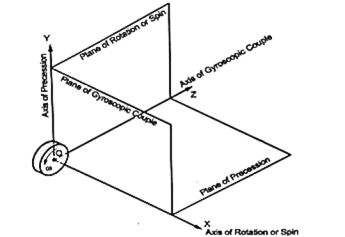
Fig. 4.1. Principle of gyroscope
Q3) Explain the Effect of gyroscopic couple on an aeroplane.
A3)
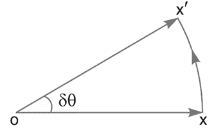
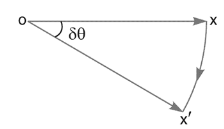
(a) Airplane taking left turn (b) Airplane taking right turn
Fig.4.2. Effect of gyroscopic couple on an aeroplane
- When the aeroplane takes a right turn under similar conditions as discussed above, the effect of the reactive gyroscopic couple will be to dip the nose and raise the tail of the aeroplane.
- When the engine or propeller rotates in anticlockwise direction when viewed from the rear or tail end and the aeroplane takes a left turn, then the effect of reactive gyroscopic couple will be to dip the nose and raise the tail of the aeroplane.
- When the aeroplane takes a right turn under similar conditions as mentioned in point 2 above, the effect of reactive gyroscopic couple will be to raise the nose and dip the tail of the aeroplane.
- When the engine or propeller rotates in clockwise direction when viewed from the front and the aeroplane takes a left turn, then the effect of reactive gyroscopic couple will be to raise the tail and dip the nose of the aeroplane.
- When the aeroplane takes a right turn under similar conditions as mentioned in point 4-above, the effect of reactive gyroscopic couple will be to raise the nose and dip the tail of the aeroplane.
Q4) Explain the Effect of gyroscopic couple on a naval ship during steering.
A4)
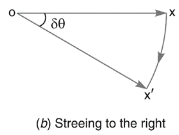
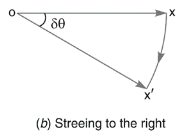
Fig.4.3. Effect of gyroscopic couple on a naval ship during steering.
1. When the ship steers to the right under similar conditions as discussed above, the effect of the reactive gyroscopic couple, as shown in Fig.(b), will be to raise the stern and lower the bow.
2. When the rotor rates in the anticlockwise direction, when viewed from the stern and the ship is steering to the left, then the effect of reactive gyroscopic couple will be to lower the bow and raise the stern.
3. When the ship is steering to the right under similar conditions as discussed in point 2 above, then the effect of reactive gyroscopic couple will be to raise the bow and lower the stern.
4. When the rotor rotates in the clockwise direction when viewed from the bow or fore end and the ship is steering to the left, then the effect of reactive gyroscopic couple will be to raise the stern and lower the bow.
5. When the ship is steering to the right under similar conditions as discussed in point 4 above, then the effect of reactive gyroscopic couple will be to raise the bow and lower the stern.
6. The effect of the reactive gyroscopic couple on a boat propelled by a turbine taking left or right turn is similar as discussed above.
Q5) Explain the Effect of gyroscopic couple on a naval ship during pitching.
A5)
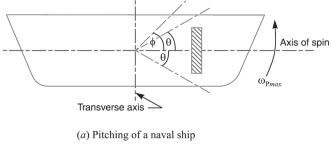
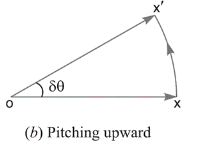
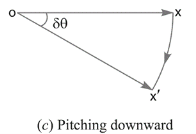
Fig.4.4. Effect of gyroscopic couple on a naval ship during pitching
When the pitching is upward, the effect of the reactive gyroscopic couple, as shown in Fig.(b), will try to move the ship toward star-board. On the other hand, if the pitching is downward, the effect of the reactive gyroscopic couple, as shown in Fig.(c), is to turn the ship towards port side.
1. The effect of the gyroscopic couple is always given on specific position of the axis of spin i.e., whether it is pitching downwards or upwards.
2. The pitching of a ship produces forces on the bearings which act horizontally and perpendicular to the motion of the ship.
3. The maximum gyroscopic couple tends to shear the holding-down bolts.
4. The angular acceleration during pitching,
The angular acceleration is maximum, if sin ω_1t = 1.
Maximum angular acceleration during pitching,

Q6) Explain the Gyroscope effect on the movement of Two-wheeled vehicle:
A6)
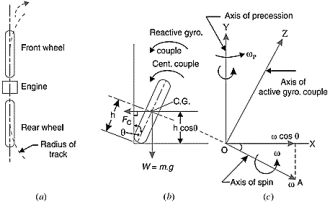
Fig.4.5. Stability of a two-wheel vehicle taking a turn
Let m = Mass of the vehicle and its rider in kg,
W = Weight of the vehicle and its rider in newtons = m.g,
h = Height of the centre of gravity of the vehicle and rider,
 = Radius of the wheels,
= Radius of the wheels,
R = Radius of track or curvature,
 = Mass moment of inertia of each wheel,
= Mass moment of inertia of each wheel,
 = Mass moment of inertia of the rotating parts of the engine,
= Mass moment of inertia of the rotating parts of the engine,
 = Angular velocity of the wheels,
= Angular velocity of the wheels,
 = Angular velocity of the engine,
= Angular velocity of the engine,
G = Gear ratio =  /
/  ,
,
v = Linear velocity of the vehicle =  ×
×  ,
,
 = Angle of heel. It is inclination of the vehicle to the vertical for equilibrium.
= Angle of heel. It is inclination of the vehicle to the vertical for equilibrium.
v =  ×
×  or
or  = v /
= v / 



Gyroscopic couple,


Q7) what are the different Gyroscopic effects on the movements of naval ships.
A7)
Steering:
Steering is the turning of a complete ship in a curve towards left or right, while it moves forward.
Consider the ship taking a left turn, and rotor rotates in the clockwise direction when viewed from the stern.
When the rotor of the ship rotates in the clockwise direction when viewed from the stern, it will have its angular momentum vector in the direction ox as shown in Fig.(a). As the ship steers to the left, the active gyroscopic couple will change the angular momentum vector from ox to ox'. The vector xx' now represents the active gyroscopic couple and is perpendicular to ox. Thus, the plane of active gyroscopic couple is perpendicular to xx' and its direction in the axis OZ for left hand turn is clockwise as shown. The reactive gyroscopic couple of the same magnitude will act in the opposite direction (i.e., in anticlockwise direction). The effect of this reactive gyroscopic couple is to raise the bow and lower the stern.
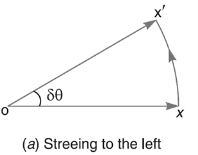
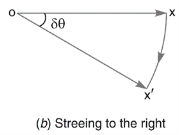
Fig.4.6. Effect of gyroscopic couple on a naval ship during steering.
Pitching:
Pitching is the movement of a complete ship up and down in a vertical plane about transverse axis, as shown in Fig.(a). In this case, the transverse axis is the axis of precession. The pitching of the ship is assumed to take place with simple harmonic motion i.e., the motion of the axis of spin about transverse axis is simple harmonic.
Rolling:
We know that, for the effect of gyroscopic couple to occur, the axis of precession should always be perpendicular to the axis of spin. If, however, the axis of precession becomes parallel to the axis of spin, there will be no effect of the gyroscopic couple acting on the body of the ship.
In case of rolling of a ship, the axis of precession (i.e., longitudinal axis) is always parallel to the axis of spin for all positions. Hence, there is no effect of the gyroscopic couple acting on the body of a ship.
Q8) Calculate couple applied to the disc causing precession in gyroscope couple.
A8)
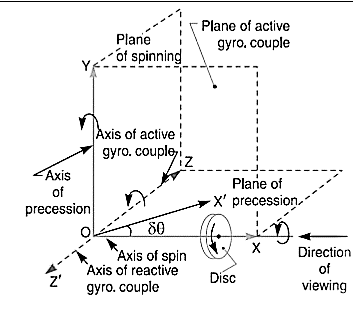
Fig.4.7.

C = Lt δt->0 I.w x δ
 = I.w x d
= I.w x d  / dt = I.w.wp
/ dt = I.w.wp

Q9) Explain Gyroscopic Couple and Gyroscopic Reaction Couple.
A9)
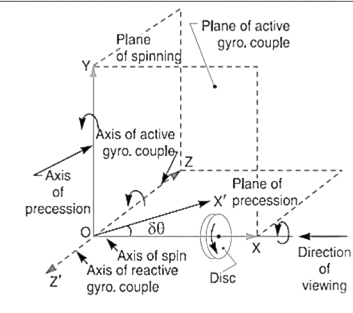
Fig.4.8. Gyroscopic Couple and reaction
The plane in which the disc is rotating is parallel to the plane YOZ, therefore it is called plane of spinning.
The plane XOZ is a horizontal plane and the axis of spin rotates in a plane parallel to the horizontal plane about an axis OY. In other words, the axis of spin is said to be rotating or processing about an axis OY. In other words, the axis of spin is said to be rotating or processing about an axis OY (which is perpendicular to both the axes OX and OZ) at an angular velocity ω_P rap/s. This horizontal plane XOZ is called plane of precession and OY is the axis of precession.

Q10) Explain the following:
- Principle of gyroscope
- Gyroscopic Couple and Gyroscopic Reaction Couple
A10)
1. Principle of gyroscope:
Whenever a body is rotating in a plane (plane YZ) about an axis (axis OX) and a couple is applied on the rotating body across the axis of rotation or spin in another perpendicular plane (plane XY), the rotating or spinning body starts processing in a third mutually perpendicular plane (plane XZ).
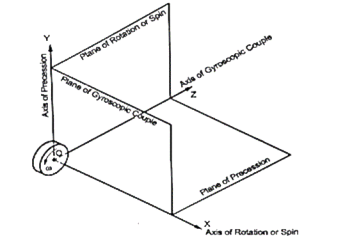
2. Gyroscopic Couple and Gyroscopic Reaction Couple:
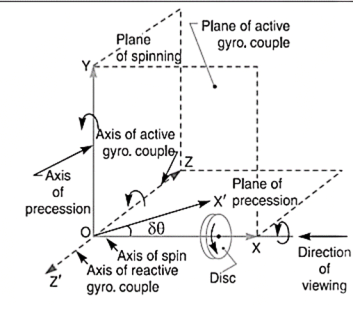
Fig.4.9. Gyroscopic Couple and Gyroscopic Reaction Couple
The plane in which the disc is rotating is parallel to the plane YOZ, therefore it is called plane of spinning.
The plane XOZ is a horizontal plane and the axis of spin rotates in a plane parallel to the horizontal plane about an axis OY. In other words, the axis of spin is said to be rotating or processing about an axis OY. In other words, the axis of spin is said to be rotating or processing about an axis OY (which is perpendicular to both the axes OX and OZ) at an angular velocity ω_P rap/s. This horizontal plane XOZ is called plane of precession and OY is the axis of precession.
